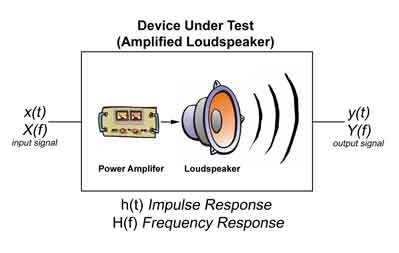
Home | The Problem | How TDS Works | Applications | Other Measurement Techniques | Future Projects

If we assume that the system under test is LTI, we can completely describe the system using either one of the two system responses, since they are related by the Fourier transform. The impulse response implies the frequency response and vice versa--each one is saying the same thing, just in a different way.
Trying to measure the system response of a loudspeaker system in a "real-world" environment can often be quite challenging. Given the finite voltage handling limits of a real-world speaker system, any attempt to apply an impulse function at the input terminals would cause the system to turn into a chunk of smoldering carbon, or at the very least, cause our system to become nonlinear.
Getting a frequency response, on the other hand, seems relatively simple. We could just feed in an electrical input signal X(f), note the mechanical (pressure) signal, Y(f), coming out of the system, and then divide the frequency output by the frequency input to get our transfer function H(f)=Y(f)/X(f).
In a real-world environment, however, using the technique described above would lead to a flawed transfer function.
Why?
Sound is a compression wave in air, and most rooms are comprised of surfaces (walls, floors, ceilings, not to mention furniture like desks and chairs), that cause acoustical scattering of the wavefront emitted by the speaker. Surfaces inside the room tend to reflect, transmit, and absorb sound to varying degrees. How a surface acts varies greatly depending upon its composition, but hard surfaces like tile tend to reflect sound, although some materials, like metal, can act as 'conductors' or 'transmitters' of sound. Softer surfaces, on the other hand, like carpet and foam, tend to absorb or 'damp' sound.
One solution to this problem is to create an environment that allows for no acoustical scattering. Such 'dead rooms', also called anechoic chambers, are usually very expensive to build and maintain.
What we need is a method to measure the response of such as system regardless of the acoustic environment in which the system is located.
One solution, usually credited to the late Dr. Richard Heyser, is called Time Delay Spectrometry. The technique was first published in the Journal of the Audio Engineering Society in October 1967.
Home | The Problem | How TDS Works | Applications | Other Measurement Techniques | Future Projects